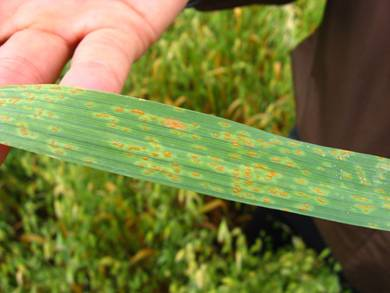Leaf diseases in cereal crops continue to rob Western Canadian farmers of yield and profit. Scald, Net Blotch, and Spot Blotch have been known to reduce barley yields up to 20%1 and Crown Rust can cause oat yield losses of 10% to 40% in the rust prone areas of Manitoba and Eastern Saskatchewan.2
While cereal farmers can manage foliar diseases effectively by reacting quickly to an outbreak in their field, the best way to protect their barley, oat and wheat crops is through making proactive disease management decisions.

Photo of Crown Rust6
Risk Factors for Disease
For windborne diseases like Net Blotch and Spot Blotch, warm humid weather, field location, topography and prevailing wind direction are important factors to consider. Scald tends to be an issue in cooler, wetter regions3 while late planting of oats followed by increased temperatures create favourable conditions for Crown Rust development.
As these leaf diseases have the ability to significantly impact yield potential in cereal crops, it is important that growers take a proactive approach to disease management. Here are six recommended proactive strategies to follow:
- Seed Quality, Variety & Treatment: Choose high quality seed from a disease-free source with good germination and vigour. Information on available varieties and their disease scores are available through provincial seed guides. Also, growing a different variety of barley each year can reduce foliar disease severity and improve yields.4
- Planting Date & Depth: Planting early and at an appropriate depth can help emergence prior to rust spores to protect against significant yield or quality loss.5
- Residue Management: Tillage may help to bury some disease inoculum. However, with windborne diseases, tillage is of little importance.
- Crop Rotation: Avoid growing cereals on a tight rotation to reduce inoculum loads.
- Fertility: A balanced fertility program is important for a high quality, high yielding crop while also increasing the crop’s tolerance to disease. A crop that is lacking nutrients will be more susceptible to disease pressure.
- Foliar Fungicides: To maximize yields in cereals, it is important to protect the flag leaf from foliar diseases. Remember to consider the disease level in the crop, the availability of spores moving in from other areas and weather conditions. Using a fungicide like Cerefit™ provides broad-spectrum control of leaf diseases in barley and oats, such as Net Blotch, Leaf Rust, Stripe Rust, Stem Rust, Crown Rust, Powdery Mildew, Septoria, Scald and Spot Blotch. For optimizal yield and flag leaf disease control, apply Cerefit at Feeke’s 9, ‘Flag Leaf out’.
Cerefit is a dual mode of action fungicide that provides both preventative and curative activity for enhanced control and excellent resistance management. Cerefit provides a unique combination of a Group 11 and Group 3 fungicide, using multiple modes of action to help manage resistance. When used in conjunction with Corteva Agriscience™ pre-seed and post emergent herbicides, Cerefit helps to ensures a healthy and clean environment for cereal crops to produce their highest yields.
For more information on Cerefit and proactive fungicide applications, download our infographic or visit your retailer or Cerefit.Corteva.ca.
This article was written in partnership with agronomist Laura Sharpe.
Footnotes:
1 https://prairiesoilsandcrops.ca/articles/volume-4-16-screen.pdf
2 http://www.prairiesoilsandcrops.ca/articles/volume-4-10-screen.pdf
3 https://www.topcropmanager.com/tracking-barley-yield-robbers/#:~:text=The%20three%20major%20leaf%20diseases,issue%20in%20cooler%2C%20wetter%20regions
4 https://priairisoilsandcrops.ca/articles/volume-4-16-screen.pdf
5 https://www.saskatchewan.ca/business/agriculture-natural-resources-and-industry/agribusiness-farmers-and-ranchers/crops-and-irrigation/disease/crown-rust-of-oat
6 https://www.saskatchewan.ca/business/agriculture-natural-resources-and-industry/agribusiness-farmers-and-ranchers/crops-and-irrigation/disease/crown-rust-of-oat





